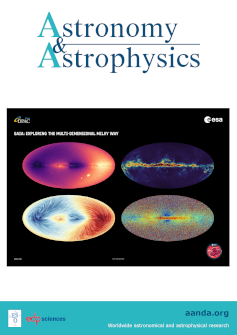Rings and arcs around evolved stars
IF 5.8
2区 物理与天体物理
Q1 ASTRONOMY & ASTROPHYSICS
引用次数: 0
Abstract
Context. A fraction of planetary nebulae (PNe) presents ring-like features in their halos and outermost envelopes. These are thought to be the relic of the last mass loss gaps at the end of the asymptotic giant branch (AGB) phase, providing information on cyclic mass-loss modulations associated either with stellar pulsations or binary interactions.Aims. We aim at characterizing the spatial and physical properties of the ring-like features around IC 418, the iconic Spirograph Nebula.Methods. Deep Very Large Telescope (VLT) Multi Unit Spectroscopic Explorer (MUSE) integral field spectroscopic observations and sharp Hubble Space Telescope (HST) images have been investigated to search for the faintest arc-like features and to characterize their physical properties.Results. Up to 10 concentric arc-like features are detected, with a notable change in the inter-ring gap, which is smaller for the innermost rings. This is interpreted as evidence of the interaction of the expanding nebula with the arc-like features, which otherwise would expand slower. The nebula proper motion also affects the shape and gap between arc-like features.Conclusions. The extinction radial profile decreases outward, indicating the presence of dust. Otherwise the electronic temperature (Te) and density (ne) derived both from emission line radial profiles and integrated spectra extracted show values around 10 000 K and 8000 cm−3, respectively. Collectively these results indicate distinct differences between the inner nebula, which is denser and more extincted, and the ring-like structures.演化恒星周围的光环和弧线
上下文。部分行星状星云(PNe)在其光晕和最外层呈现环状特征。这些被认为是在渐近巨支(AGB)阶段结束时最后一个质量损失间隙的遗迹,提供了与恒星脉动或双星相互作用相关的循环质量损失调制的信息。我们的目标是描述IC 418(标志性的螺旋星云)周围环状特征的空间和物理特性。研究了深甚大望远镜(VLT)多单元光谱探测器(MUSE)的积分场光谱观测和哈勃太空望远镜(HST)的锐利图像,以寻找最微弱的弧形特征并表征它们的物理性质。最多可检测到10个同心弧形特征,环间间隙变化明显,最内层环的间隙较小。这被解释为膨胀星云与弧形特征相互作用的证据,否则它会膨胀得更慢。星云的固有运动也会影响形状和弧状特征之间的间隙。消光径向轮廓向外减小,表明存在尘埃。另外,从发射线径向轮廓和提取的综合光谱中得到的电子温度(Te)和密度(ne)分别显示在10 000 K和8000 cm−3左右。总的来说,这些结果表明了内部星云与环状结构之间的明显差异,内部星云密度更大,更暗淡。
本文章由计算机程序翻译,如有差异,请以英文原文为准。
求助全文
约1分钟内获得全文
求助全文
来源期刊

Astronomy & Astrophysics
地学天文-天文与天体物理
CiteScore
10.20
自引率
27.70%
发文量
2105
审稿时长
1-2 weeks
期刊介绍:
Astronomy & Astrophysics is an international Journal that publishes papers on all aspects of astronomy and astrophysics (theoretical, observational, and instrumental) independently of the techniques used to obtain the results.
 求助内容:
求助内容: 应助结果提醒方式:
应助结果提醒方式:


